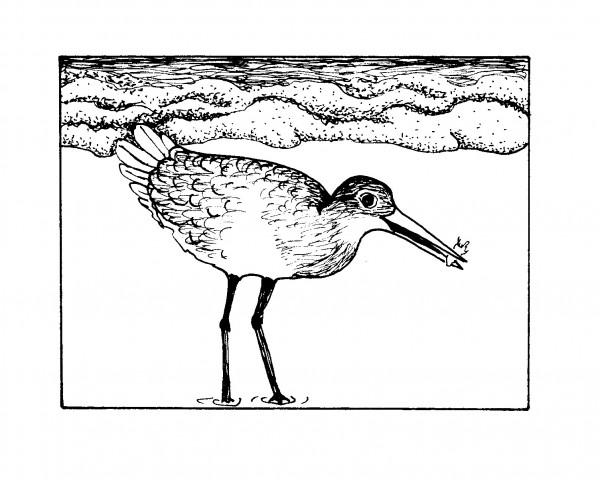By Mia Davidson and Jan Sattler

Now that the summer crowds have dispersed, the Western Willet (Tringa semipalmata) has arrived on the beaches of Laguna. The mottled bird is colored light gray-brown with a pale belly, a long, dark straight bill and gray legs with partially webbed feet. It is the most common of the large sandpiper family found wintering on our coast. Only visible when open in flight, the Willet has striking black and white bands of feathers on its wings. Both males and females are similar in appearance and average approximately 15 inches tall with the female slightly larger. They can live approximately 10 years.
Having a wide wintering range on the coasts of Oregon to Peru, the bird is mostly seen in coastal wetlands and along the open beach at low tide. Omnivores that are occasionally found feeding on small fish and plant material in the tidepools, the Willet is most often seen on the wet part of the beach, deliberately probing the sand with its sensitive bill for crustaceans, mollusks, marine worms and insects. Vocal when disturbed, they make a distinctive cry.
A nocturnal migrant, the Western Willet will remain on the coast until approximately April next year, when it will depart to its inland breeding grounds which include northeast California, Nevada and central Canada in freshwater habitats such as wetlands, lakeshores, grasslands and marshes. Although Willets tend to be monogamous for long periods of time, pairs do not stay together throughout the year. Only breeding once a year, Willets make colonies with hidden nests along ponds and wetlands. Laying usually four eggs, they are very territorial in protecting the eggs and young. Both parents brood the eggs and raise the young until they are about one month old. It is during this nesting period that the willet is most vulnerable to predators such as raptors, ravens, raccoons, foxes and coyotes. In addition, they are increasingly colliding with power lines that have been erected in or near their nesting territories.
The Migratory Bird Treaty Act of 1918 made it unlawful to kill or possess migratory birds and since then, populations have increased and remained relatively steady in recent decades. However, they are carefully monitored because of habitat loss due to coastal and urban development in their wintering territories and agriculture conversion of grasslands in their breeding territories. Opportunities to observe Willets in Laguna are best on the beach during low tides in the early morning or late afternoon. Laguna Beach is a refuge for a wide variety of migratory species that travel along the Pacific Flyway and in 1978 was designated a Bird Sanctuary, (Ord. 918 § 1 (part), 1978) thus they are not to be disturbed or harassed.
Residents and ocean swimmers Mia Davidson and Jan Sattler encourage everyone to protect Laguna’s coastal resources as you are enjoying them.




